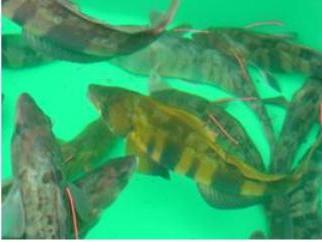The fish rasp has a slender and laterally compressed body, along which light and dark wide stripes alternate. His dorsal fin is gray, with a narrow black border, solid and long. The belly and bottom of the head are yellow.
Rasp fish has several names in the people. Fishermen call it red rasp, sea lenok or red perch. In urban markets, sellers simply call it perch or rasp. But from experts you will hear about the Kuril snakehead or rabbit rasp, because such a translation has the Latin name of the species.
Rasp fish - photo
This fish is well known to everyone who at least once went fishing in Avacha Bay, it is often caught in the coastal zone. Zaitsegolov lives extensively in the Pacific Ocean, namely, in the northern part, meeting along the entire Asian coast, starting from the Yellow Sea and ending with the Barents Sea. And then its habitat extends along the American coast all the way to California. But most often it can be found in the waters of southeastern Kamchatka and the Kuril Islands.
Rasp fish is quite large. Its weight exceeds 2.5 kg, and its length is more than 55 cm. Seasonal migrations are typical for rasp. In late May or early June, coastal waters warm up enough, and it fits into the shallow zone (20-30 m depth) for spawning. The reef zone with patches of rocky soil is the place where the rasp fish is found during spawning. As a rule, it is kept in the zone of underwater vegetation, since it is a substrate for its eggs.

The spawning period of the rasp is quite extended, this is due to the proportion of spawning. At first, males accumulate in the spawning places, they select the most suitable sites. Females swim into these protected areas, they start spawning in portions. After the spawning is completed, the females leave the place of spawning. But the males remain on guard of the masonry until the larvae hatch. For protection, only brightly colored and largest individuals of males remain. After the embryonic development of caviar ends, and this happens from the beginning to the middle of October, the hare-headed rasp begins to move away from the coast. He plunges into wintering to a depth of 300 m. But his juveniles first live in the water column, and only after reaching a certain size will it go on to the bottom lifestyle.
Rasp fish is omnivorous. She even during spawning continues to eat actively. Basically, her diet includes various crustaceans, small fish and mollusks.
The terpug does not disdain the waste of the
fishing industry, and the caviar of other fish is used, as, indeed, of the gapeous brethren. And I must say that caviar is a component of his diet.
Rasp fish is an object of marine fishermen in Kamchatka. Its largest abundance is observed in the ocean waters of Southeast Kamchatka and the Northern Kuril Islands. Sometimes it comes across in the western waters and off the southwestern coast of the Bering Sea. Most often, individuals over 1.5 kg and up to 49 cm in length are caught. As soon as spring heating begins, the rasp is moved to coastal waters. At the end of March, its jambs appear at a depth of 200 meters, and in April it already goes on the shelf. In coastal waters, fish are easily caught, you can even not go out on a boat, but just go deeper into the water.